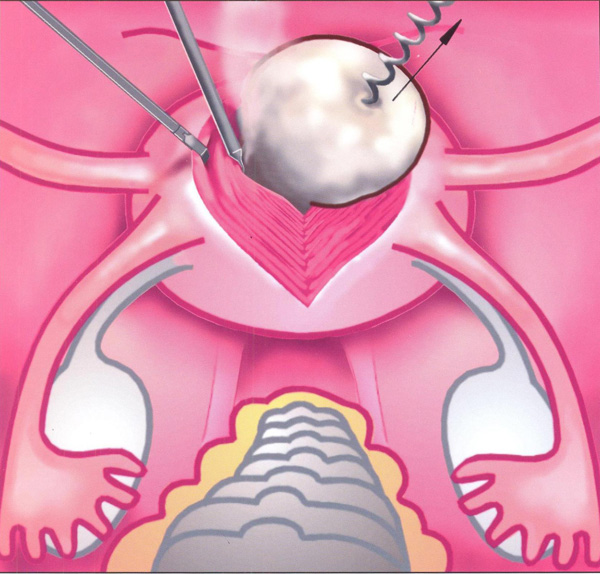- Department of Gynecology and Obstetrics
- • Comprehensive treatment of uterine fibroids
- Myomectomy
- Hysteroscopy
- Embolisation
Myomectomy
LAPAROSCOPIC MYOMECTOMY (LM) + (LUAO)
Myomectomy means the removal of fibroids from the uterus. It is performed under general anaesthesia either laparoscopically, and if the findings are not suitable for laparoscopy, the procedure is continued via laparotomy, i.e. the abdominal cavity is opened classically from an incision. Hospitalization usually lasts 3 to 6 days.
In the case of a submucous fibroid, the larger part of which protrudes into the uterine cavity, it can then be removed by hysteroscopy. The removed fibroid is always examined histologically to clarify the biological nature of the fibroid.
Procedure
In the vast majority of cases, the surgery begins endoscopically; under general anaesthesia, a hysteroscopy is first performed, during which the shape and possible irregularities in the uterine cavity are clarified, then a laparoscopy is added, which allows the entire abdominal cavity to be evaluated, focusing on the gynaecological organs. If the risk of the procedure is greater than its benefit (risk of removal of the uterus, injury to large vessels or organs of the abdominal cavity, etc.), we prefer to withdraw from the intention to remove the fibroid surgically, and the treatment of the fibroid can then be conducted in another way, e.g. by embolization of the uterine arteries (UAE) or magnetic resonance guided ultrasound (MRgFUS). First experiences with hormonal treatment are also available.
In the case of a larger number of fibroids, laparoscopic occlusion of the main trunks of both uterine arteries (LUAO) can be added to the enucleation, which significantly reduces blood flow through the fibroid. This has the effect of stopping further growth of the fibroid(s) and sometimes shrinking it. The uterus, which has a vascular supply from other arteries, will not be endangered by this procedure.
A defect in the uterine wall that occurs after a myomectomy is treated with sutures, usually in several layers. The surgery usually takes 60 to 120 minutes.
Where the defect was extensive, we suggest that the patient undergo a control laparoscopy after about 2 to 3 months, possibly also a hysteroscopy, so that we can accurately evaluate the condition of the scar.
In the case of desired pregnancy, we do not recommend this earlier than 6 months after the procedure. Where the injury was extensive, we usually advise to terminate the pregnancy by planned caesarean section.
Postoperative checks are to be performed 1, 6 and 12 months after the procedure in the Outpatient Endoscopy Clinic of the Department of Gynaecology and Obstetrics
 Laparoscopic fibroid removal
Laparoscopic fibroid removal
